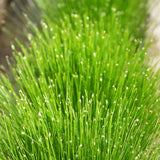Myriophyllum Brasiliensis Red Stem Aquatic Pond Plant - Brazilian Water Milifoil
Myriophyllum brasiliensis, commonly known as Brazilian watermilfoil, is an aquatic plant species native to South America. It is a popular choice for aquariums and water gardens due to its attractive appearance and ease of care.
Here is a detailed description and care guide for Myriophyllum brasiliensis:
Description:
Myriophyllum brasiliensis is a submerged aquatic plant that features delicate, feathery leaves. The leaves are arranged in whorls around the stem, giving the plant a graceful and bushy appearance. The leaves are typically green in color, but can sometimes exhibit reddish tones under certain conditions. The stems are slender and can grow up to 30-50 cm (12-20 inches) in length, making it a good mid-ground or background plant in an aquarium or pond.
Care Guide:
Lighting: Myriophyllum brasiliensis thrives in moderate to high lighting conditions. Provide it with at least 3-4 watts per gallon of full-spectrum lighting to promote healthy growth and vibrant coloration.
Water Parameters: This plant prefers slightly acidic to neutral water conditions with a pH range of 6.5-7.5. The temperature should be kept between 22-28°C (72-82°F). Maintain good water quality by performing regular water changes and monitoring ammonia, nitrite, and nitrate levels.
Substrate: Plant Myriophyllum brasiliensis in a nutrient-rich substrate or use root tabs to provide it with essential nutrients. A fine-grained substrate or sand works well for this plant.
CO2 and Fertilization: While not strictly necessary, providing supplemental CO2 and regular fertilization can enhance the growth and overall health of Myriophyllum brasiliensis. CO2 injection and a comprehensive liquid fertilizer can help promote vibrant growth and prevent nutrient deficiencies.
Propagation: Myriophyllum brasiliensis can be propagated through stem cuttings. Simply cut off a healthy stem and replant it in the substrate. The plant will develop new roots and continue growing.
Pruning: Regular pruning is necessary to maintain the bushy shape and prevent overgrowth. Trim back any excessive growth to control the size and encourage new lateral shoots.
Compatibility: Myriophyllum brasiliensis is generally compatible with a wide range of fish and invertebrates. However, avoid keeping it with herbivorous species that may consume or damage the delicate leaves.
With proper care and maintenance, Myriophyllum brasiliensis can create a beautiful and natural-looking aquatic display in your aquarium or pond. Monitor its growth regularly, adjust care parameters as needed, and enjoy the lush green foliage it adds to your aquatic setup.
Selection of Plants:
Choose appropriate oxygenating plants that are suitable for the size and depth of your pond. Common oxygenating plants include Hornwort (Ceratophyllum), Anacharis (Elodea canadensis), Waterweed (Elodea densa), and Watermilfoil (Myriophyllum species).
Placement:
Place oxygenating plants in the water at a depth where their foliage is fully submerged. Distribute the plants evenly throughout the pond, ensuring they receive adequate sunlight for photosynthesis.
Water Quality:
Oxygenating plants play a crucial role in maintaining good water quality by absorbing excess nutrients, competing with algae for resources, and releasing oxygen through photosynthesis. Regularly monitor water quality parameters such as pH, ammonia, nitrite, and nitrate levels to ensure they are within suitable ranges for the plants.
Nutrient Levels:
Oxygenating plants benefit from moderate nutrient levels in the water, but excessive nutrients can lead to rapid algae growth. Avoid over-fertilization or excessive organic matter accumulation in the pond, as it can negatively impact oxygenating plants.
Pruning and Maintenance:
Regularly thin out and prune oxygenating plants to prevent overcrowding and ensure healthy growth. Remove any dead or decaying plant material promptly to maintain water quality and prevent the release of excess nutrients.
Winter Care:
Some oxygenating plants may need special attention during winter, especially in colder climates. If your pond experiences freezing temperatures, consider moving potted plants indoors or provide insulation to protect them. In milder climates, oxygenating plants may continue to grow during winter, providing oxygen and supporting the pond ecosystem.
Propagation:
Some oxygenating plants can be propagated by dividing or taking cuttings. Follow specific instructions for each plant species to propagate them successfully and maintain a healthy population in your pond.
Monitoring and Control:
Regularly observe the growth and condition of oxygenating plants to identify any signs of disease, pests, or nutrient deficiencies. If needed, control excessive growth by removing excess plant material, but be careful not to remove too much at once, as it can disturb the pond's ecological balance.
Introduction of New Plants:
Before introducing new oxygenating plants into your pond, ensure they are free from pests, diseases, or invasive species. Avoid introducing non-native species that may become invasive and harm the local ecosystem. By following these general tips and care guidelines, you can maintain healthy oxygenating plants in your pond. They will contribute to the overall oxygenation of the water, provide habitat for beneficial organisms, and promote a thriving pond ecosystem.


































